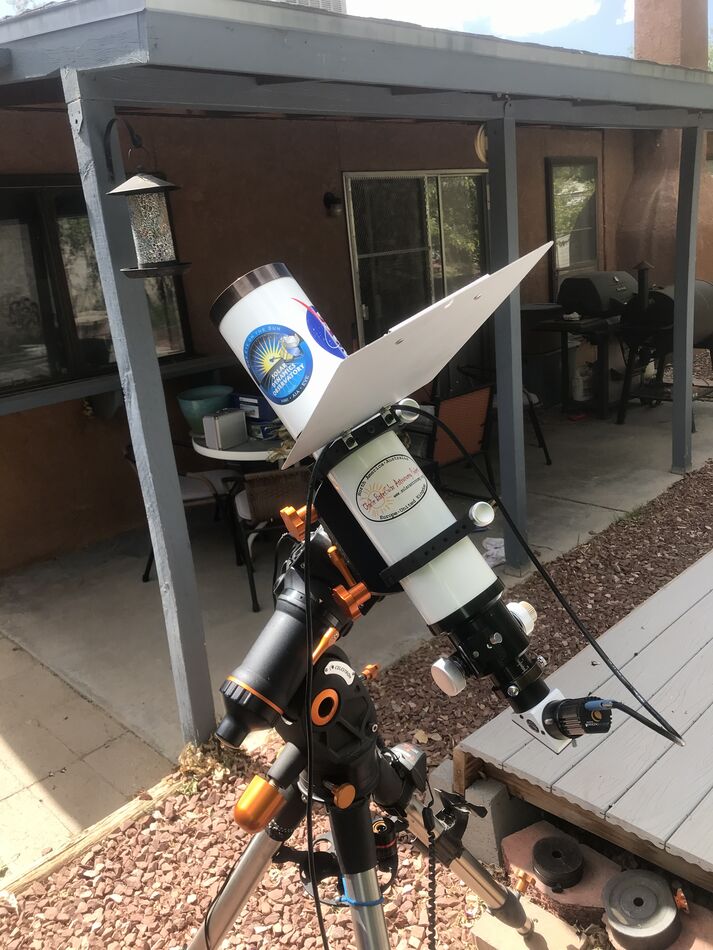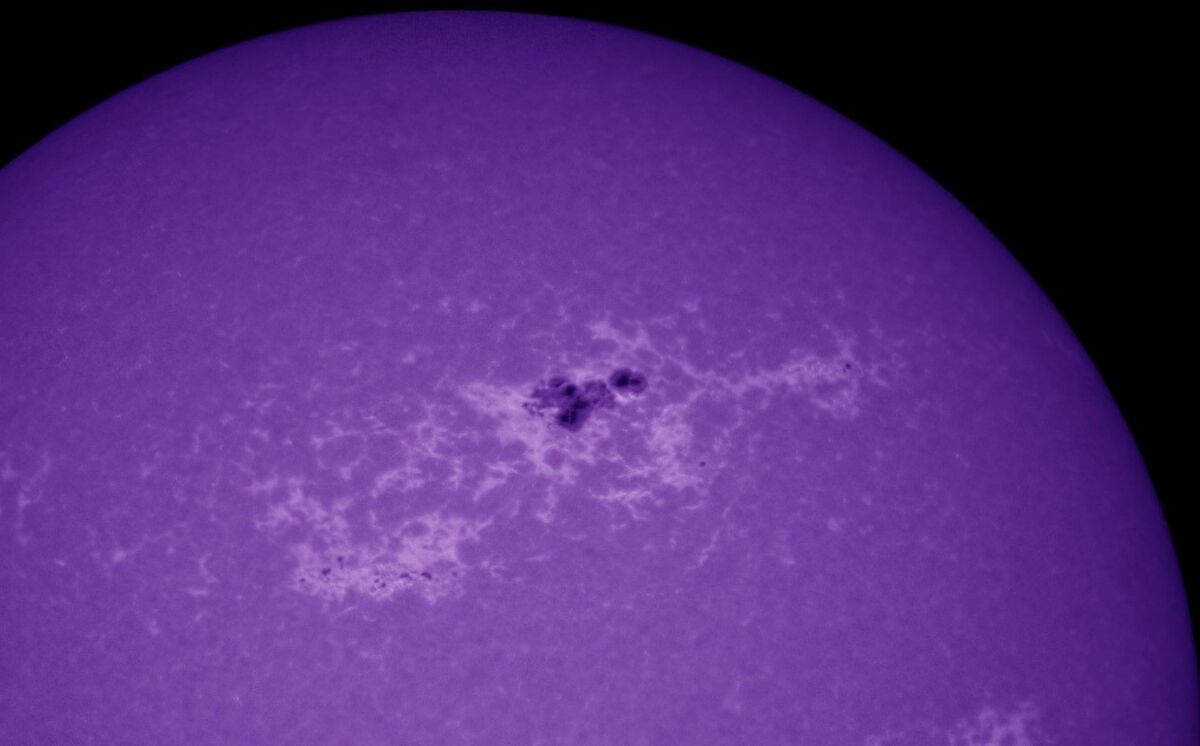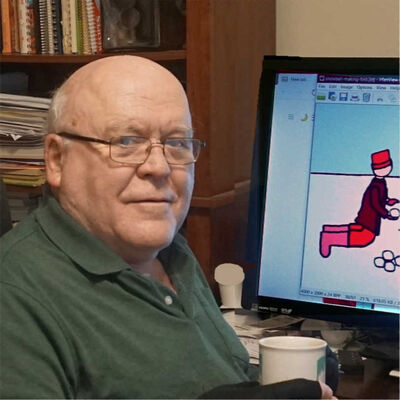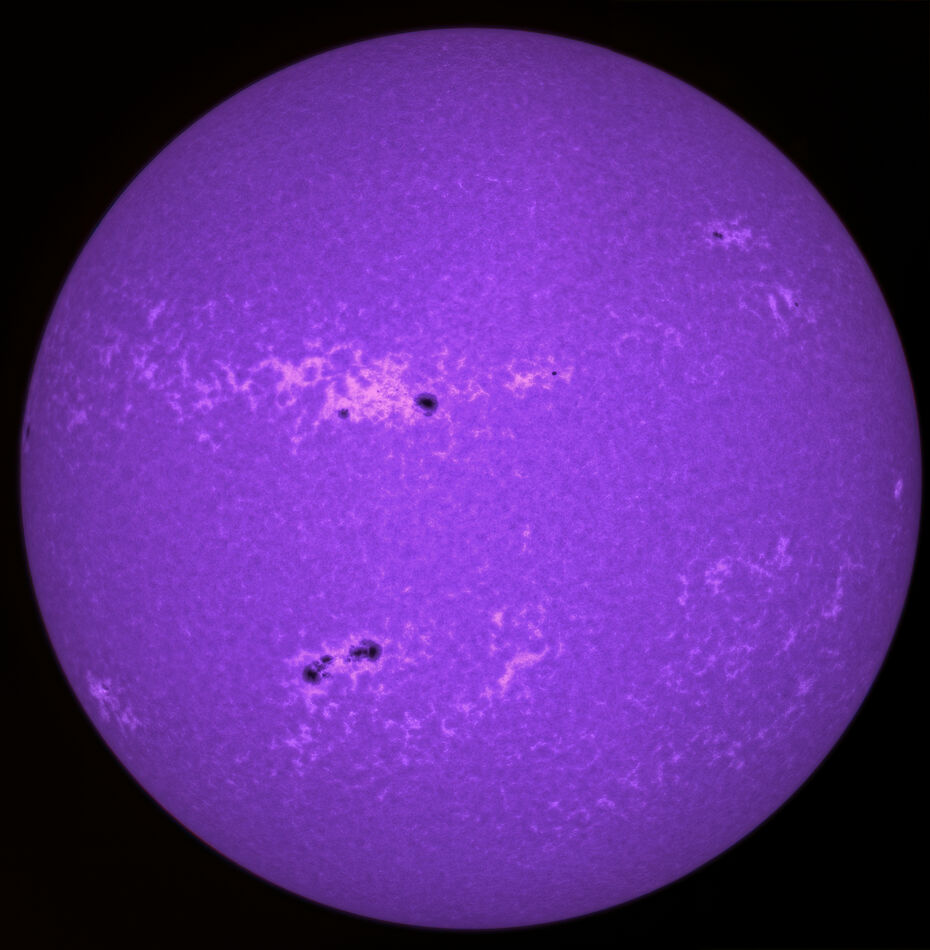Shooting solar with a CaK blocking filter
Aug 8, 2022 15:34:03 #
This is something that I recently started shooting and I have been very pleased with the results.
This is shooting in the 3900nm range or ultraviolet.
I use a Lunt 102mm doublet telescope with a Lunt CaK 1200 blocking filter.
Images are captured with a Skyris 236M CMOS camera.
I shot 20 second videos, usually at 30 - 60 frames per second depending on the resolution I am shooting.
I stack 10% of the captured video with autostakkert3 and process the stacked photo in Photoshop adding color back into the image.
I have to focus with the laptop because most people cannot see details of CaK directly. I see a purple circle lacking detail but it becomes very clear on screen.
I’ll post my photo train and a resulting photo.
Stay safe.
This is shooting in the 3900nm range or ultraviolet.
I use a Lunt 102mm doublet telescope with a Lunt CaK 1200 blocking filter.
Images are captured with a Skyris 236M CMOS camera.
I shot 20 second videos, usually at 30 - 60 frames per second depending on the resolution I am shooting.
I stack 10% of the captured video with autostakkert3 and process the stacked photo in Photoshop adding color back into the image.
I have to focus with the laptop because most people cannot see details of CaK directly. I see a purple circle lacking detail but it becomes very clear on screen.
I’ll post my photo train and a resulting photo.
Stay safe.
Aug 9, 2022 09:36:55 #
Albuqshutterbug wrote:
This is something that I recently started shooting... (show quote)
Minor PT 390 nm, too many 0's.
Aug 9, 2022 10:25:58 #
JBRIII wrote:
Minor PT 390 nm, too many 0's.
Correct, I missed that in my editing.
Thank you.
Jim
Aug 9, 2022 11:50:52 #
Albuqshutterbug wrote:
This is something that I recently started shooting... (show quote)
Very nice! The filter does an excellent job on contrast.
bwa
Aug 9, 2022 15:19:11 #
Looks very good, Jim.
On some reading I have done, they suggested that one can view the granulations just below the Sun's surface in this near uv light. Have you seen anything like that? Is this an exceptionally large sunspot, or is the upper shadow from the lens/lens tube? --Richard
On some reading I have done, they suggested that one can view the granulations just below the Sun's surface in this near uv light. Have you seen anything like that? Is this an exceptionally large sunspot, or is the upper shadow from the lens/lens tube? --Richard
Aug 10, 2022 00:30:54 #
profbowman wrote:
Looks very good, Jim.
On some reading I have done, they suggested that one can view the granulations just below the Sun's surface in this near uv light. Have you seen anything like that? Is this an exceptionally large sunspot, or is the upper shadow from the lens/lens tube? --Richard
On some reading I have done, they suggested that one can view the granulations just below the Sun's surface in this near uv light. Have you seen anything like that? Is this an exceptionally large sunspot, or is the upper shadow from the lens/lens tube? --Richard
This is the actual area. This is all that fits in the image. I have to shoot the sun in 6 pieces and stitch to get a full image with this setup.
Jim
Aug 10, 2022 00:32:16 #
bwana wrote:
Very nice! The filter does an excellent job on contrast.
bwa
bwa
Thank you.
I wasn’t sure if I would like this but it sure pulls the detail.
Jim
Aug 10, 2022 08:54:17 #
Albuqshutterbug wrote:
This is the actual area. This is all that fits in the image. I have to shoot the sun in 6 pieces and stitch to get a full image with this setup.
Jim
Jim
Thanks, Jim. I thought that might be the case. --Richard
Aug 11, 2022 12:20:17 #
Here is the stitched image.
Yep those spots are pretty large.
It creates a pretty large file and this has been reduced a bit.
Jim
Here’s a blurb from the Lunt description of the filter spectrum.
“The Calcium K modules line is centered at 393.4 nm. This wavelength is considered to be slightly outside the visible spectrum on the UV side. While most people can visually see the violet color of the wavelength, many cannot resolve the contrast due to yellowing of the cornea. People who have had cataract surgery are often able to see considerable detail. But, it is for these reasons that the Ca-K line is typically studied via the use of cameras, which are able to provide stunning details.“
Yep those spots are pretty large.
It creates a pretty large file and this has been reduced a bit.
Jim
Here’s a blurb from the Lunt description of the filter spectrum.
“The Calcium K modules line is centered at 393.4 nm. This wavelength is considered to be slightly outside the visible spectrum on the UV side. While most people can visually see the violet color of the wavelength, many cannot resolve the contrast due to yellowing of the cornea. People who have had cataract surgery are often able to see considerable detail. But, it is for these reasons that the Ca-K line is typically studied via the use of cameras, which are able to provide stunning details.“
Aug 11, 2022 13:55:29 #
Aug 13, 2022 07:11:52 #
Thanks for stitching images together and posting the result, Jim. It looks good. --Richard
Aug 13, 2022 17:11:36 #
Ballard
Loc: Grass Valley, California
Albuqshutterbug wrote:
This is something that I recently started shooting... (show quote)
Very nice Calcium K-line shots. How narrow band is your filter, does it cover both the K and H lines?



Aug 17, 2022 13:33:38 #
Ballard wrote:
Very nice Calcium K-line shots. How narrow band is your filter, does it cover both the K and H lines? 





Thank you for your compliment.
H and K are close to the 393.4nm wavelength. The Lunt filter is specific to K line.
H is lower and is sometimes captured with less specific filters like Daystar.
I hope this answers your question.
Aug 17, 2022 13:37:16 #
bwana wrote:
Great image!
Thank you very much.
It’s an expensive filter but very well made.
I wasn’t sure if it was something I was going to use a lot but it’s becoming a favorite.
Stay safe
Aug 17, 2022 13:40:24 #
profbowman wrote:
Thanks for stitching images together and posting the result, Jim. It looks good. --Richard
Thank you very much for the compliment.
The Skyris 236 series does a great job of capturing but the sensor is small. I just have to capture more photons to get a full image.

If you want to reply, then register here. Registration is free and your account is created instantly, so you can post right away.




